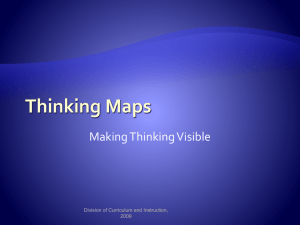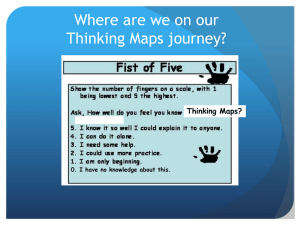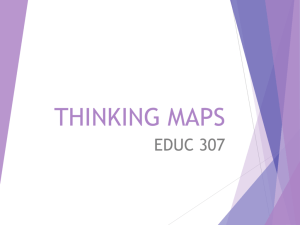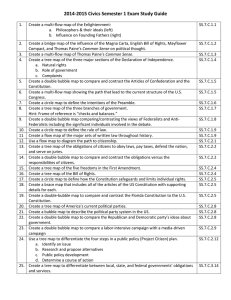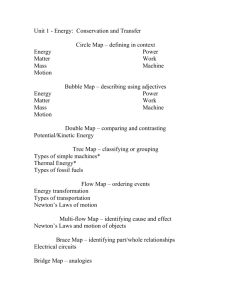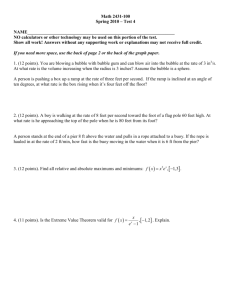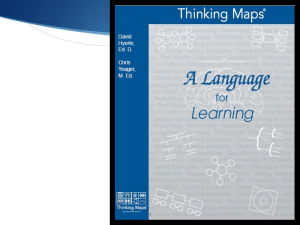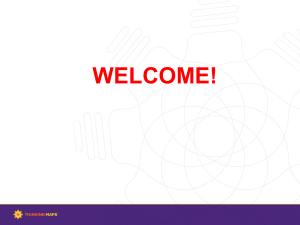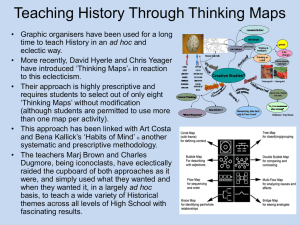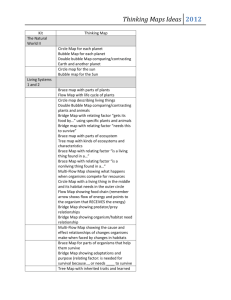Thinking+Maps
advertisement
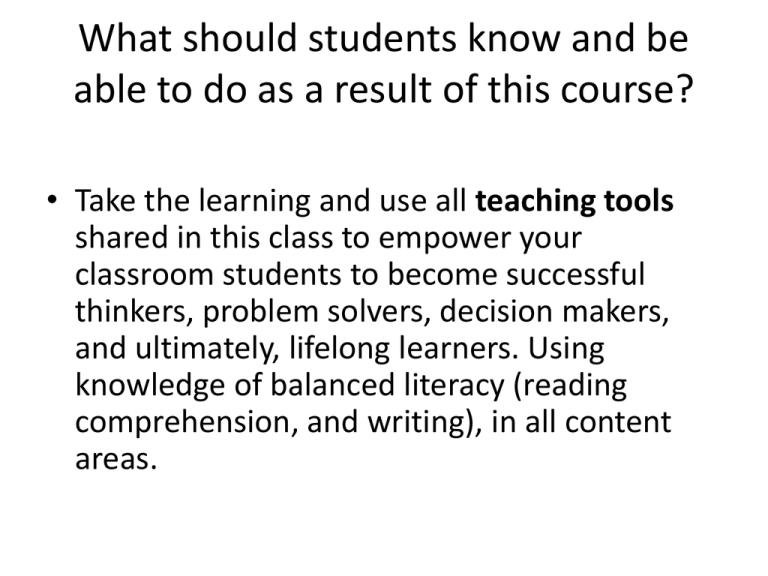
What should students know and be able to do as a result of this course? • Take the learning and use all teaching tools shared in this class to empower your classroom students to become successful thinkers, problem solvers, decision makers, and ultimately, lifelong learners. Using knowledge of balanced literacy (reading comprehension, and writing), in all content areas. How? Discuss • What is the relationship between thinking and learning? How have/do teachers teach thinking in your observations of classroom experiences? • Examples, what does that thinking look like in classrooms? My thinking • So my goal for you as students and future educators…is that you will empower your students to become critical thinkers, and problem solvers bold enough to ask questions and find the answers. • This course should build your toolbox….giving new tools or new ways to use those old tools …ultimately empowering your students to share/tell their thinking with themselves and others……… becoming life long learners. Thinking Maps - A Language for Learning • Thinking Maps® were developed as a language for learning in 1988 by Dr. David Hyerle. There are eight maps; maps can be used by teachers and students (K-12; pre-K; adult education, university and business) for reading comprehension, writing process problem solving, and thinking skills improvement. One School-Thinking Maps http://www.mindsofmississippi.com/ Why Thinking Maps? • Thinking Maps unite students across all grade levels and in all content areas through the use of a common visual language for thinking. Thinking Maps are not content- or grade-level specific. They are specifically designed to promote and strengthen the skillful use of fundamental cognitive processes for all learning. When using Thinking Maps… • You use an inquiry approach to learning; asking questions and visually representing ideas. • Thinking Maps strengthen the use of inquirybased processes and support student’s participation and engagement. Thinking Maps first grade • http://www.thinkingfoundation.org/video/clip s/mtairy-1st-org-thinking.html 8 Maps • Thinking Maps are based on fundamental cognitive skills such as comparing and contrasting, sequencing, classifying, and causeeffect reasoning. Much like carpenters using a set of tools, multiple Thinking Maps are used as an eight maps icon toolkit by students for constructing knowledge: for improving the basics of reading, writing, and mathematics as well as for problem-solving and the development of higher-order thinking abilities. 8 maps Teacher Interview • http://www.thinkingfoundation.org/video/clip s/norman-howard-mr-k.html Benefits • Students learn more effectively and more efficiently • Objectives are covered in less time with greater retention • Thought processes are represented similarly throughout the curricula • Schools also promote integrated thinking and interdisciplinary learning • Teachers can easily gauge student knowledge prior to a specific lesson • Student performance can be tracked accurately over time • Students gain effective tools to use across their academic and working careers • Lifelong thinking tools Youtube thinking maps • http://youtu.be/JYqpf0x4RlA Robert Marzano, Ph.D……Where have we heard this name? • "Knowledge is stored in two forms: linguistic and nonlinguistically. Research proves that the more we use both systems of representation the better we are able to think and recall knowledge.“ Circle Map • The Circle Map is used for brainstorming ideas and for showing prior knowledge about a topic by providing context information. • “Tell me everything you know about pollution and how you know these things. What experiences have you had that taught you about pollution?” Circle Map Bubble Map • The Bubble Map is used for describing using adjectives (and adjective phrases). Unlike the Circle Map which is used for brainstorming, The Bubble Map is a tool for enriching students' abilities to identify qualities and use descriptive words. • “Use vivid language to describe the characters in the story. Be sure to include not only words the author uses but descriptors you can infer from the story as well.” Bubble Map Flow Map • The Flow Map is used by students for sequencing and ordering information. • “Explain in writing the steps you followed to solve this problem.” Flow Map Brace Map • The Brace Map is used by students to analyze physical objects. On the line to the left is the name or image of the whole object. On the lines within the first brace to the right are the major parts. • “Analyze the structure of the computer to determine its parts and subparts.” Brace Map Tree Map • The Tree Map is used by students for classifying things and ideas. • “Take a position on a topic and classify your main reasons for that position. Be sure to include specific details and examples to support each of your reasons.” Tree Map Double Bubble Map • The Double Bubble Map is a tool for comparing and contrasting things. • “Examine the similarities and differences between these two geometric figures.” Double Bubble Multi-Flow Map • The Multi-Flow Map is used by students for showing and analyzing cause and effect relationships. In the center rectangle is an important event. On the left side of the event is the causes, and on the right side of the event the effects. • “Discuss what might cause tooth decay and tell some of the effects of poor dental hygiene.” Multi-Flow Bridge Map • The Bridge Map gives students a tool for applying the process of seeing analogies. • “Choose two historical leaders and show their relationship to important movements or conflicts. Remember to state your relating factor.” Bridge Map Making a Difference as a Teacher • http://www.youtube.com/watch?v=XzE7wCxR a5Q&feature=related
